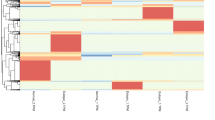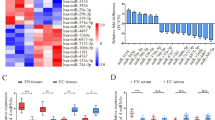Abstract
Endometriosis is a chronic disease that affects roughly 5–15 % of women of reproductive age. The pathophysiology of the disease occurrence and progression is unclear. MicroRNAs (miRNAs) are short, non-coding RNAs that have important regulatory function. It has been postulated that abnormal expression of miRNA is associated with ovarian endometriosis. Forty patients with ovarian endometriosis and 20 controls with benign ovarian tumor were included to examine the expression level of miR-20a. Quantitative real-time PCR (qPCR) was performed to detect the expression level of miR-20a. The target genes and pathways involved in aberrantly expressed miR-20a were identified by computational algorithms. Furthermore, selected target genes expression level were analyzed by qPCR. Significantly increased miR-20a expression level was observed in patients with ovarian endometriosis as compared with controls. Further stratified analysis showed that the increased expression level of miR-20a was only associated with advanced endometriosis (stage III–IV), but not mild endometriosis (stage I–II). The cell cycle was identified to be one of the most relevant pathways in the pathogenesis of endometriosis conducted by miR-20a. The expression level of target gene NTN4 (netrin-4) was significantly decreased in patients with ovarian endometriosis. The results of this study suggest that increased expression of miR-20a may play an important role in the pathogenesis of ovarian endometriosis by suppressing NTN4.


Similar content being viewed by others
References
Bulun SE (2009) Endometriosis. N Engl J Med 360:268–279
Gao X, Outley J, Botteman M, Spalding J, Simon JA, Pashos CL (2006) Economic burden of endometriosis. Fertil Steril 86:1561–1572
Hemmings R, Rivard M, Olive DL, Poliquin-Fleury J, Gagne D, Hugo P, Gosselin D (2004) Evaluation of risk factors associated with endometriosis. Fertil Steril 81:1513–1521
Sampson JA (1927) Metastatic or embolic endometriosis, due to the menstrual dissemination of endometrial tissue into the venous circulation. Am J Pathol 3(93–110):43
Assaf BT, Miller AD (2012) Pleural endometriosis in an aged rhesus macaque (Macaca mulatta): a histopathologic and immunohistochemical study. Vet Pathol 49:636–641
Doshi N, Fujikura T (1978) Squamous cell passage from the peritoneal cavity to lymph glands and pulmonary lymphatics in a malformed infant: a mechanism for endometriosis and pulmonary metastasis. Am J Obstet Gynecol 131:221–223
Dmowski WP, Steele RW, Baker GF (1981) Deficient cellular immunity in endometriosis. Am J Obstet Gynecol 141:377–383
Rana N, Braun DP, House R, Gebel H, Rotman C, Dmowski WP (1996) Basal and stimulated secretion of cytokines by peritoneal macrophages in women with endometriosis. Fertil Steril 65:925–930
Mok-Lin EY, Wolfberg A, Hollinquist H, Laufer MR (2010) Endometriosis in a patient with Mayer-Rokitansky-Kuster-Hauser syndrome and complete uterine agenesis: evidence to support the theory of coelomic metaplasia. J Pediatr Adolesc Gynecol 23:e35–e37
Suginami H (1991) A reappraisal of the coelomic metaplasia theory by reviewing endometriosis occurring in unusual sites and instances. Am J Obstet Gynecol 165:214–218
Du H, Taylor HS (2007) Contribution of bone marrow-derived stem cells to endometrium and endometriosis. Stem Cells 25:2082–2086
Osuga Y, Koga K, Tsutsumi O, Igarashi T, Okagaki R, Takai Y, Matsumi H, Hiroi H, Fujiwara T, Momoeda M, Yano T, Taketani Y (2000) Stem cell factor (SCF) concentrations in peritoneal fluid of women with or without endometriosis. Am J Reprod Immunol 44:231–235
Teague EM, Print CG, Hull ML (2010) The role of microRNAs in endometriosis and associated reproductive conditions. Hum Reprod Update 16:142–165
Fabian MR, Sonenberg N, Filipowicz W (2010) Regulation of mRNA translation and stability by microRNAs. Annu Rev Biochem 79:351–379
Berezikov E, Guryev V, van de Belt J, Wienholds E, Plasterk RH, Cuppen E (2005) Phylogenetic shadowing and computational identification of human microRNA genes. Cell 120:21–24
Gorur A, Balci Fidanci S, Dogruer Unal N, Ayaz L, Akbayir S, Yildirim Yaroglu H, Dirlik M, Serin MS, Tamer L (2012) Determination of plasma microRNA for early detection of gastric cancer. Mol Biol Rep 40(3):2091–2096
Oliveira-Carvalho V, Silva MM, Guimaraes GV, Bacal F, Bocchi EA (2012) MicroRNAs: new players in heart failure. Mol Biol Rep 40(3):2663–2670
Ge Y, Zhao K, Qi Y, Min X, Shi Z, Qi X, Shan Y, Cui L, Zhou M, Wang Y, Wang H (2013) Serum microRNA expression profile as a biomarker for the diagnosis of pertussis. Mol Biol Rep 40:1325–1332
Wu W, Hu Z, Qin Y, Dong J, Dai J, Lu C, Zhang W, Shen H, Xia Y, Wang X (2012) Seminal plasma microRNAs: potential biomarkers for spermatogenesis status. Mol Hum Reprod 18:489–497
Wu W, Qin Y, Li Z, Dong J, Dai J, Lu C, Guo X, Zhao Y, Zhu Y, Zhang W, Hang B, Sha J, Shen H, Xia Y, Hu Z, Wang X (2013) Genome-wide microRNA expression profiling in idiopathic non-obstructive azoospermia: significant up-regulation of miR-141, miR-429 and miR-7-1-3p. Hum Reprod 28:1827–1836
Marsh EE, Lin Z, Yin P, Milad M, Chakravarti D, Bulun SE (2008) Differential expression of microRNA species in human uterine leiomyoma versus normal myometrium. Fertil Steril 89:1771–1776
Pan Q, Chegini N (2008) MicroRNA signature and regulatory functions in the endometrium during normal and disease states. Semin Reprod Med 26:479–493
Pan Q, Luo X, Chegini N (2008) Differential expression of microRNAs in myometrium and leiomyomas and regulation by ovarian steroids. J Cell Mol Med 12:227–240
Wang T, Zhang X, Obijuru L, Laser J, Aris V, Lee P, Mittal K, Soteropoulos P, Wei JJ (2007) A micro-RNA signature associated with race, tumor size, and target gene activity in human uterine leiomyomas. Genes Chromosom Cancer 46:336–347
Zhang L, Volinia S, Bonome T, Calin GA, Greshock J, Yang N, Liu CG, Giannakakis A, Alexiou P, Hasegawa K, Johnstone CN, Megraw MS, Adams S, Lassus H, Huang J, Kaur S, Liang S, Sethupathy P, Leminen A, Simossis VA, Sandaltzopoulos R, Naomoto Y, Katsaros D, Gimotty PA, DeMichele A, Huang Q, Butzow R, Rustgi AK, Weber BL, Birrer MJ, Hatzigeorgiou AG, Croce CM, Coukos G (2008) Genomic and epigenetic alterations deregulate microRNA expression in human epithelial ovarian cancer. Proc Natl Acad Sci USA 105:7004–7009
Jia SZ, Yang Y, Lang J, Sun P, Leng J (2012) Plasma miR-17-5p, miR-20a and miR-22 are down-regulated in women with endometriosis. Hum Reprod 28(2):322–330
Burney RO, Hamilton AE, Aghajanova L, Vo KC, Nezhat CN, Lessey BA, Giudice LC (2009) MicroRNA expression profiling of eutopic secretory endometrium in women with versus without endometriosis. Mol Hum Reprod 15:625–631
Kao LC, Germeyer A, Tulac S, Lobo S, Yang JP, Taylor RN, Osteen K, Lessey BA, Giudice LC (2003) Expression profiling of endometrium from women with endometriosis reveals candidate genes for disease-based implantation failure and infertility. Endocrinology 144:2870–2881
Ohlsson Teague EM, Van der Hoek KH, Van der Hoek MB, Perry N, Wagaarachchi P, Robertson SA, Print CG, Hull LM (2009) MicroRNA-regulated pathways associated with endometriosis. Mol Endocrinol 23:265–275
Pan Q, Luo X, Toloubeydokhti T, Chegini N (2007) The expression profile of micro-RNA in endometrium and endometriosis and the influence of ovarian steroids on their expression. Mol Hum Reprod 13:797–806
Megraw M, Sethupathy P, Corda B, Hatzigeorgiou AG (2007) miRGen: a database for the study of animal microRNA genomic organization and function. Nucleic Acids Res 35:D149–D155
Shigetomi H, Higashiura Y, Kajihara H, Kobayashi H (2012) A potential link of oxidative stress and cell cycle regulation for development of endometriosis. Gynecol Endocrinol 28:897–902
Yamamoto S, Tsuda H, Miyai K, Takano M, Tamai S, Matsubara O (2010) Cumulative alterations of p27-related cell-cycle regulators in the development of endometriosis-associated ovarian clear cell adenocarcinoma. Histopathology 56:740–749
Olive V, Jiang I, He L (2010) mir-17-92, a cluster of miRNAs in the midst of the cancer network. Int J Biochem Cell Biol 42:1348–1354
Zhao HY, Ooyama A, Yamamoto M, Ikeda R, Haraguchi M, Tabata S, Furukawa T, Che XF, Iwashita K, Oka T, Fukushima M, Nakagawa M, Ono M, Kuwano M, Akiyama S (2008) Down regulation of c-Myc and induction of an angiogenesis inhibitor, thrombospondin-1, by 5-FU in human colon cancer KM12C cells. Cancer Lett 270:156–163
Lin SC, Wang CC, Wu MH, Yang SH, Li YH, Tsai SJ (2012) Hypoxia-induced microRNA-20a expression increases ERK phosphorylation and angiogenic gene expression in endometriotic stromal cells. J Clin Endocrinol Metab 97:E1515–E1523
Pickering MT, Stadler BM, Kowalik TF (2009) miR-17 and miR-20a temper an E2F1-induced G1 checkpoint to regulate cell cycle progression. Oncogene 28:140–145
O’Donnell KA, Wentzel EA, Zeller KI, Dang CV, Mendell JT (2005) c-Myc-regulated microRNAs modulate E2F1 expression. Nature 435:839–843
Eveno C, Broqueres-You D, Feron JG, Rampanou A, Tijeras-Raballand A, Ropert S, Leconte L, Levy BI, Pocard M (2011) Netrin-4 delays colorectal cancer carcinomatosis by inhibiting tumor angiogenesis. Am J Pathol 178:1861–1869
Acknowledgments
We thank Mei Lu and Xiaohong Yuan for sample and questionnaire data collection and processing. This work was supported by National Natural Science Foundation of China (No. 81100437), China Postdoctoral Science Foundation (No. 2013M531388), the Priority Academic Program for the Development of Jiangsu Higher Education Institutions (Public Health and Preventive Medicine).
Author information
Authors and Affiliations
Corresponding authors
Additional information
Min Zhao and Qiuqin Tang contributed equally to this study and they should be regarded as joint first authors.
Electronic supplementary material
Below is the link to the electronic supplementary material.
Rights and permissions
About this article
Cite this article
Zhao, M., Tang, Q., Wu, W. et al. miR-20a contributes to endometriosis by regulating NTN4 expression. Mol Biol Rep 41, 5793–5797 (2014). https://doi.org/10.1007/s11033-014-3452-7
Received:
Accepted:
Published:
Issue Date:
DOI: https://doi.org/10.1007/s11033-014-3452-7




